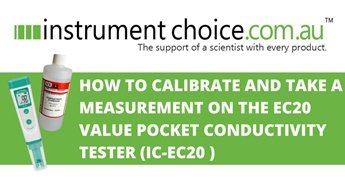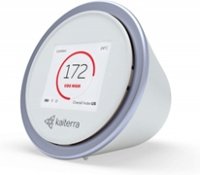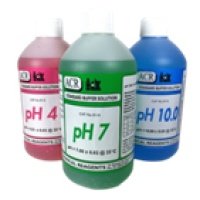How to Calibrate and Take a Measurement on the EC20 Value Pocket Conductivity Kit (IC-EC20 )

The IC-EC20 conductivity meter is a durable instrument offering two-point calibration, automatic temperature compensation and automatic range adjustment. This unit is a popular choice for measuring conductivity in tap drinking water, swimming pools, water treatment plants, hydroponic operations, and various educational applications.
The IC-EC20 Pocket Conductivity kit includes a meter and everything you could need to calibrate and take straightforward conductivity measurements.
Figure 1 Watch an Instrument Choice scientist demonstrate how to calibrate and take a measurement on the EC20 Value Pocket Conductivity Tester here.
How to Calibrate and Take a Measurement on the EC20 Value Pocket Conductivity Kit (IC-EC20)
Materials
You will need;
- The IC-EC20 Value Pocket Conductivity kit
- EC20 Meter,
- 1413µS/cm; and
- 88mS/cm calibration solutions; and
- Distilled or Deionised water for rinsing.
Calibration
The IC-EC20 features automatic buffer recognition for 1413µS/cm and 12.88mS/cm calibration standards. Users can choose to perform either a 1 or 2 point calibration. Note: In most circumstances, 1413µS/cm will meet calibration requirements, but select your buffer or buffers based on your expected measurement range and required accuracy.
- Press the POWER button to switch on the meter.
- Enter the conductivity calibration mode by long-pressing the “CAL” button for around 3-seconds. The screen will briefly display “CAL” before entering calibration mode.
- Immerse the sensor into the 1413µS/cm buffer solution and wait. The available buffers (1413µS/cm and 12.88mS/cm) will blink on the second half of the LCD as the meter recognises the solution.
- When recognised and stable, the standard buffer solution 1413µS/cm will remain on the screen, and the stability indicator smiley face will appear.
- Short press the “CAL” button to complete the first point of calibration. When calibration to 1413µS/cm is successful, the calibration icon “M” will appear on the LCD.
- The unit will automatically return to measurement mode.
- If you are calibrating to a second point, repeat steps 2-5. When your 12.88mS/cm calibration has completed, ‘H” will appear on the LCD next to the “M”.
- The meter is calibrated and ready to take measurements.

Taking a Measurement
By default, the IC-EC20 tester automatically ranges between µS and mS. So to ensure accurate recording of results, it is essential to take note of the given range. When readings are greater than 2000 µS/cm, the display will show mS/cm.
- To take a conductivity measurement with your calibrated meter, place the electrode into the sample, ensuring the electrode sensors are entirely submerged.
- Record your conductivity reading after the smiley face stability indicator appears on the LCD.
- Rinse the electrode in distilled or deionised water between measurements.
Conclusion
Instrument Choice supplies the all-inclusive IC-EC20 Value Pocket Conductivity kit with everything you could ever require to perform conductivity measuring tasks. Examples include regular conductivity testing in applications such as hydroponics, education, tap drinking water, swimming pools and water treatments.
For more information on the IC-EC20 Value Pocket Conductivity kit, see the links below or contact us!
Additional links
- View the Value Pocket Conductivity kit here
- Watch “How to Calibrate and Take a Measurement on the EC20 Value Pocket Conductivity Kit (IC-EC20)” again
- Want to see what comes in the box? Watch an Instrument Choice scientist “Unboxing the EC20 Value Pocket Conductivity Kit (IC-EC20)”
- View all pH and conductivity meters by Apera Instruments
- Click here to browse all conductivity meters and conductivity kits at Instrument Choice

Also interesting
If the air in your home or office seems stale or stuffy, if you feel drowsy or have difficulty concentrating be careful - the culprit may be elevated Carbon Dioxide concentrations!
Carbon dioxide forms as a byproduct of our metabolism and gets expelled from our bodies when we breathe. As winter approaches and the weather cools, we will spend less time with open windows and doors. Inadequate ventilation leads to higher concentrations of CO2.

Keeping your pH meter calibrated is the best way to ensure consistent and accurate pH measurements. A pH buffer solution is essential to calibrate a pH meter accurately.
Find out where to buy pH buffer solutions here

